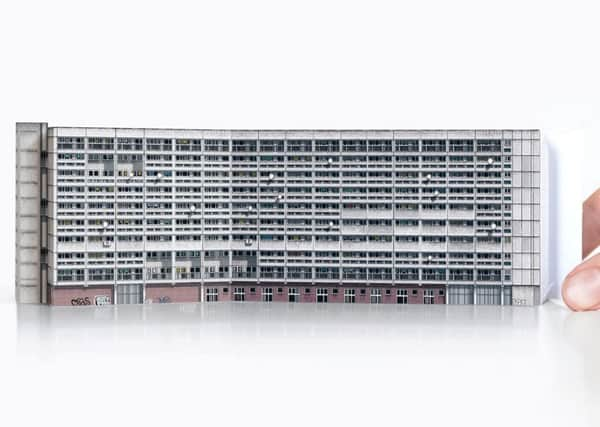Trainspotting Leith ‘Banana Flats’ named as top UK landmark


Cables Wynd House, which dates from 1965, is described as “a monument of Scottish modernist architecture” in the new book, Brutal Britain, which has been released by a Polish publisher.
Billed as a celebration of British “Brutalist” architecture, it claims the development took living standards in Edinburgh “to the next level” on its completion in 1965.
Advertisement
Hide AdAdvertisement
Hide AdThe book concedes that they are best known as “the drug estate that housed Simon ‘Sick Boy’ Williamson in Trainspotting, but also adds: “There is definitely more to this raw construction.”
It states: “Viewing Edinburgh’s post-war redevelopment from the air, one block stands out: Cables Wynd House.”
The Banana Flats have been included in the book two years after being given category A-listed status by government agency Historic Environment Scotland, shortly after the release of Trainspotting sequel T2.
The book adds: “The housing was A-listed for its ‘excellence in modernist urban design’. Indeed the architects, Alison & Hutchison & Partners, following the example of Le Corbusier’s Unite d’Habitation, designed a landmark of the Brutalist style.”
The Banana Flats are rated alongside Arlington House, the site of Britain’s first “park and buy” shopping centre, in Margate, Cotton Gardens Estate, in Lambeth, and a Manchester tower block dubbed The Toast Rack.
The new book also features Glasgow’s Hutchesontown C blocks - nicknamed “Hutchie C” and “The Hanging Gardens of the Gorbals” after they were completed in 1965. They were demolished in 1993 after falling into disrepair.
David Navarro, co-founder of Zupagrafika, publishers of Brutal Britain, said: “The buildings selected for this book make up a very diverse collection of British post-war modernist and brutalist constructions, from housing estates to more well-known concrete designs. Some of those buildings are still standing, but others, like Birmingham Central Library, have sadly been demolished.
“We carefully studied and illustrated the original designs of all these constructions and featured all the peculiarities visible on their facades due to the passing of time and human intervention (like the original grafitti, TV antennas or patches of dirt), so they could be reconstructed by readers as they were before demolition or renovation. Cables Wynd House was actually an obvious choice for us, not only because of ‘Trainspotting’, but mainly because it is a striking piece of concrete architecture.
Advertisement
Hide AdAdvertisement
Hide Ad“The fact it was listed only made the choice easier for us - we knew it needed to be part of ‘Brutal Britain’. Unlike many of its concrete neighbours that are already demolished, like the Glasgow’s Hutchesontown C, the Banana Flats are still standing and have become a true landmark of Brutalist architecture.”
Dawn McDowell, deputy head of designations at Historic Environment Scotland, said: “We’re delighted that our decision to list Leith’s iconic Cables Wynd House has been featured in ‘Brutal Britain’.
“The flats have been an integral and instantly recognisable feature of the Leith skyline since they were constructed in the early 1960s and have entered into popular culture thanks to being featured in Irvine Welsh’s Trainspotting novel.
“At the time it was built, Cables Wynd House was the largest block of flats in Edinburgh, and possibly the most accomplished architecturally. It is one of the best examples of the new approach to housing schemes in the 1960s, which was to create not just houses, but communities too.”
Rosie Ellison, manager of the Film Edinburgh commission, which helped finddozens of locations for T2, said: “Cables Wynd House is an iconic part of Leith and as such is part of the landscape that makes Leith an attractive place for filmmakers to put on the screen.
“Brutalist architecture is often overlooked, however there have been a few films and TV dramas over the years which have celebrated it, including Wedding Belles, T2 Trainspotting and a host of factual programmes.”
He continued: “It’s great to see Brutal Britain recognising these buildings and doing so in such an interesting format.”
Leith councillor Gordon Munro said: “It’s great to see this grade A-listed building getting the recognition it deserves.”